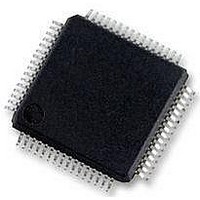MC56F8257MLH Freescale Semiconductor, MC56F8257MLH Datasheet - Page 343

MC56F8257MLH
Manufacturer Part Number
MC56F8257MLH
Description
DSC 64K FLASH 60MHZ 64-LQFP
Manufacturer
Freescale Semiconductor
Series
56F8xxxr
Datasheets
1.TWR-56F8257.pdf
(88 pages)
2.MC56F8245VLD.pdf
(14 pages)
3.MC56F8245VLD.pdf
(2 pages)
4.MC56F8245VLD.pdf
(629 pages)
Specifications of MC56F8257MLH
Core Processor
56800E
Core Size
16-Bit
Speed
60MHz
Connectivity
CAN, I²C, LIN, SCI, SPI
Peripherals
LVD, POR, PWM, WDT
Number Of I /o
54
Program Memory Size
64KB (32K x 16)
Program Memory Type
FLASH
Ram Size
4K x 16
Voltage - Supply (vcc/vdd)
3 V ~ 3.6 V
Data Converters
A/D 16x12b, D/A 1x12b
Oscillator Type
Internal
Operating Temperature
-40°C ~ 105°C
Package / Case
64-LQFP
Product
DSCs
Processor Series
56800E
Core
56800E
Device Million Instructions Per Second
60 MIPs
Maximum Clock Frequency
60 MHz
Number Of Programmable I/os
54
Data Ram Size
8 KB
Operating Supply Voltage
3.3 V
Maximum Operating Temperature
+ 105 C
Mounting Style
SMD/SMT
Minimum Operating Temperature
- 40 C
On-chip Adc
12 bit, 8 Channel
Lead Free Status / RoHS Status
Lead free / RoHS Compliant
Eeprom Size
-
Lead Free Status / Rohs Status
Details
Available stocks
Company
Part Number
Manufacturer
Quantity
Price
Company:
Part Number:
MC56F8257MLH
Manufacturer:
MOTOLOLA
Quantity:
560
Company:
Part Number:
MC56F8257MLH
Manufacturer:
Freescale Semiconductor
Quantity:
10 000
- TWR-56F8257 PDF datasheet
- MC56F8245VLD PDF datasheet #2
- MC56F8245VLD PDF datasheet #3
- MC56F8245VLD PDF datasheet #4
- Current page: 343 of 629
- Download datasheet (4Mb)
10.4.4.1.4 FAST ACK and NACK
To improve reliability and communication robustness, implementation of packet error
checking (PEC) by SMBus devices is optional for SMBus devices but required for
devices participating in and only during the address resolution protocol (ARP) process.
The PEC is a CRC-8 error checking byte, calculated on all the message bytes. The PEC is
appended to the message by the device that supplied the last data byte. If the PEC is
present but not correct, a NACK is issued by the receiver. Otherwise an ACK is issued.
In order to calculate the CRC-8 by software, this module can hold the SCL line low after
receiving the eighth SCL (8th bit) if this byte is a data byte. So software can determine
whether an ACK or NACK should be sent to the bus by setting or clearing the TXAK bit
if the FACK (fast ACK/NACK enable) bit is enabled.
SMBus requires a device always to acknowledge its own address, as a mechanism to
detect the presence of a removable device (such as a battery or docking station) on the
bus. In addition to indicating a slave device busy condition, SMBus uses the NACK
mechanism to indicate the reception of an invalid command or invalid data. Because such
a condition may occur on the last byte of the transfer, SMBus devices are required to
have the ability to generate the not acknowledge after the transfer of each byte and before
the completion of the transaction. This requirement is important because SMBus does not
provide any other resend signaling. This difference in the use of the NACK signaling has
implications on the specific implementation of the SMBus port, especially in devices that
handle critical system data such as the SMBus host and the SBS components.
10.4.5 Resets
The I2C module is disabled after a reset. The I2C module cannot cause a core reset.
10.4.6 Interrupts
The I2C module generates an interrupt when any of the events in the following table
occur, provided that the IICIE bit is set. The interrupt is driven by the IICIF bit (of the
I2C Status Register) and masked with the IICIE bit (of the I2C Control Register 1). The
IICIF bit must be cleared (by software) by writing 1 to it in the interrupt routine. The
Freescale Semiconductor
In the last byte of master receive slave transmit mode, the
master must send a NACK to the bus, so FACK must be
switched off before the last byte transmits.
MC56F825x/4x Reference Manual, Rev. 2, 10/2010
Preliminary
NOTE
Chapter 10 Inter-Integrated Circuit (I2C)
343
Related parts for MC56F8257MLH
Image
Part Number
Description
Manufacturer
Datasheet
Request
R
Part Number:
Description:
Manufacturer:
Freescale Semiconductor, Inc
Datasheet:
Part Number:
Description:
Manufacturer:
Freescale Semiconductor, Inc
Datasheet:
Part Number:
Description:
Manufacturer:
Freescale Semiconductor, Inc
Datasheet:
Part Number:
Description:
Manufacturer:
Freescale Semiconductor, Inc
Datasheet:
Part Number:
Description:
Manufacturer:
Freescale Semiconductor, Inc
Datasheet:
Part Number:
Description:
Manufacturer:
Freescale Semiconductor, Inc
Datasheet:
Part Number:
Description:
Manufacturer:
Freescale Semiconductor, Inc
Datasheet:
Part Number:
Description:
Manufacturer:
Freescale Semiconductor, Inc
Datasheet:
Part Number:
Description:
Manufacturer:
Freescale Semiconductor, Inc
Datasheet:
Part Number:
Description:
Manufacturer:
Freescale Semiconductor, Inc
Datasheet:
Part Number:
Description:
Manufacturer:
Freescale Semiconductor, Inc
Datasheet:
Part Number:
Description:
Manufacturer:
Freescale Semiconductor, Inc
Datasheet:
Part Number:
Description:
Manufacturer:
Freescale Semiconductor, Inc
Datasheet:
Part Number:
Description:
Manufacturer:
Freescale Semiconductor, Inc
Datasheet:
Part Number:
Description:
Manufacturer:
Freescale Semiconductor, Inc
Datasheet:











